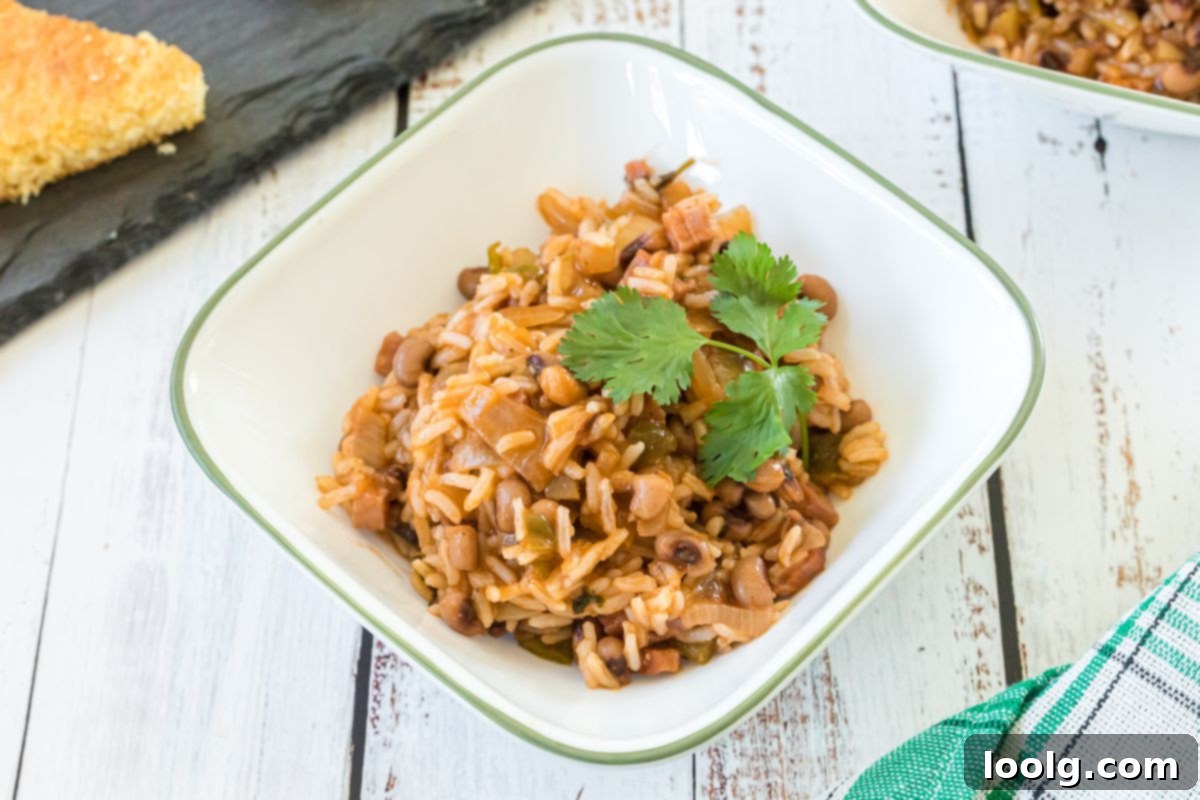Easy Slow Cooker Hoppin’ John: Your Gluten-Free & Dairy-Free New Year’s Recipe for Luck and Flavor
As the festive holiday season draws to a close, many of us look forward to ringing in the New Year with cherished traditions, good company, and, of course, delicious food. If you’re searching for a comforting, hearty, and incredibly easy dish to bring luck and flavor to your New Year’s table, look no further than this classic Southern favorite: Hoppin’ John. Also lovingly known as Carolina peas and rice or simply black-eyed peas and rice, this wholesome meal combines savory ham or bacon with tender black-eyed peas, aromatic onions, and a medley of spices, all cooked effortlessly in your slow cooker. It’s the ultimate “dump and cook” recipe, perfect for busy New Year’s Day celebrations, and is naturally gluten-free and dairy-free, making it accessible for almost everyone.
While the holiday season often overflows with sweet treats, there’s a unique satisfaction in preparing a savory, traditional dish that carries generations of history and good wishes. This Hoppin’ John recipe offers just that – a deeply flavorful, robust meal that promises a simple cooking experience without compromising on taste or cultural significance. It’s time to embrace a culinary tradition that’s both nourishing for the body and believed to bring prosperity for the year ahead.
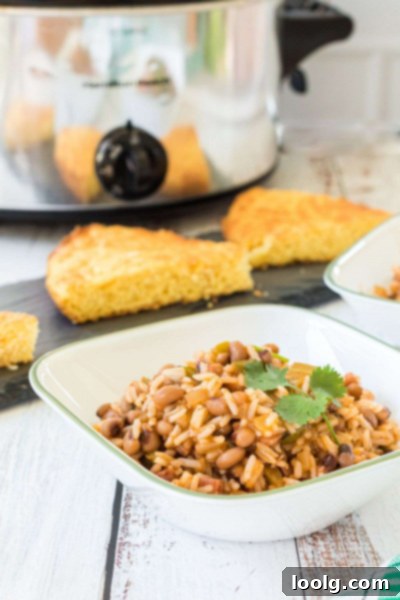
Tracing the Roots: A Rich History of Hoppin’ John
Just like many cherished regional dishes, Hoppin’ John isn’t just a recipe; it’s a culinary artifact with a compelling story. This traditional Southern staple boasts roots stretching back to the 1840s, originating from the vibrant Gullah Geechee communities of the Carolina Lowcountry. The dish first appeared in print in Sarah Rutledge’s renowned cookbook, The Carolina Housewife, published in 1847. However, its true origins undoubtedly predate this, stemming from the resourcefulness and culinary expertise of enslaved Africans in the American South, who often adapted available ingredients to create nourishing and flavorful meals.
The fertile river deltas and marshy lands of the South Carolina Lowcountry were ideal for cultivating rice, which became a foundational grain in the region’s cuisine. Paired with local legumes, particularly red peas (a variety of cowpea), the combination formed the basis of this hearty dish. Over time, as the recipe spread throughout the South and red peas became harder to source in certain areas, the more readily available black-eyed peas took their place, eventually becoming the standard for Hoppin’ John as we know it today.
The enigmatic name “Hoppin’ John” has sparked numerous theories, and its true derivation remains a delightful mystery. Before sharing this recipe, I conducted some research to ensure the name wasn’t derogatory. Fortunately, historians generally agree that it carries no negative connotations. Some speculate it may have evolved from the French phrase pois à pigeon, referring to “pigeon peas,” which were similar to the cowpeas originally used. Other theories suggest it might come from children hopping around the table in anticipation of the meal, or even from vendors calling “Hopping John!” to attract customers. While the exact origin of the name is lost to time, its enduring legacy as a symbol of Southern comfort food and New Year’s good fortune is undeniable.
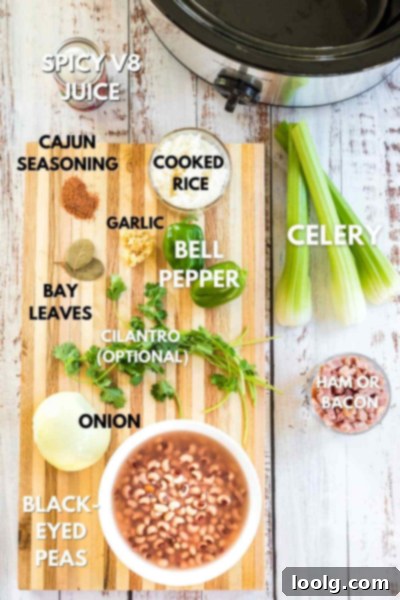
A Tradition Steeped in Luck: The Hoppin’ John Superstition
For many, New Year’s Day is not just about celebration; it’s also about setting intentions and welcoming good fortune. Hoppin’ John is at the heart of this tradition in the Southern United States, believed to bring prosperity and luck for the upcoming year. While I may not be particularly superstitious, the rich symbolism behind this dish, especially when served with its traditional companions of collard greens and cornbread, is a beautiful way to usher in a fresh start.
Black-Eyed Peas for Prosperity
The consumption of black-eyed peas for good luck on New Year’s is a practice with a history spanning over 1,500 years, with some tracing its roots back to ancient Egypt. However, the tradition’s deep-seated presence in the American South is predominantly attributed to African slaves, who brought with them a rich cultural heritage and symbolic foodways. Author Jessica Harris, a renowned scholar of African-American culture, highlights this connection, sharing stories of men carrying black-eyed peas in their wallets as talismans for prosperity. This belief was further solidified and spread across the country post-Civil War, as newly freed slaves, skilled in cooking and agriculture, took roles in the expanding railroad industry, sharing their customs from generation to generation.
The symbolism of black-eyed peas is multi-faceted: they are said to resemble coins, promising financial prosperity. The act of “eating poor on New Year’s Day to eat rich the rest of the year” also plays into this, signifying humility and hope for future abundance. Each pea represents a day of good fortune, making it a powerful symbol for the year ahead.
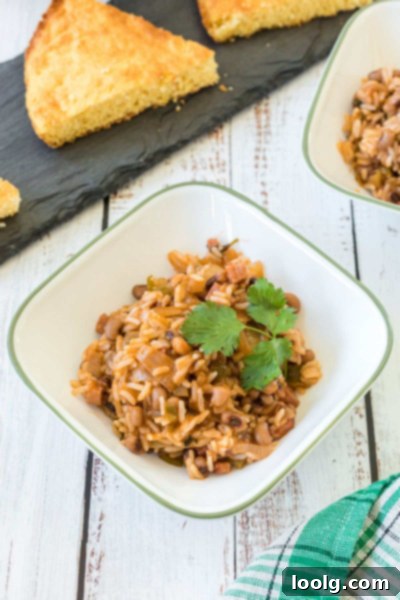
Collard Greens for Wealth
Alongside the lucky black-eyed peas, collard greens are an essential accompaniment to Hoppin’ John on New Year’s Day. These vibrant green leafy vegetables are believed to symbolize money, specifically paper currency. The popular saying goes that for every bite of collard greens (or other leafy greens like cabbage or mustard greens) you eat, you could gain a significant amount of wealth in the coming year – some even optimistically claim $1,000 per bite! While a fun superstition, the inclusion of collard greens also adds essential nutrients and a delicious, slightly bitter counterpoint to the savory Hoppin’ John. For a perfect pairing, these spicy Southern collard greens with bacon would be an excellent choice.
Cornbread for Gold
Completing the lucky trifecta is cornbread, often served warm and crusty alongside Hoppin’ John and collard greens. Cornbread, with its golden hue, symbolizes gold and the hope for extra spending money or financial success throughout the year. It adds a delightful texture and a slightly sweet, earthy flavor that complements the richness of the peas and ham. My personal favorite is this Dairy-free Cornbread recipe, which is incredibly versatile and can be made with regular buttermilk, whole wheat, or gluten-free flour, catering to various dietary needs.
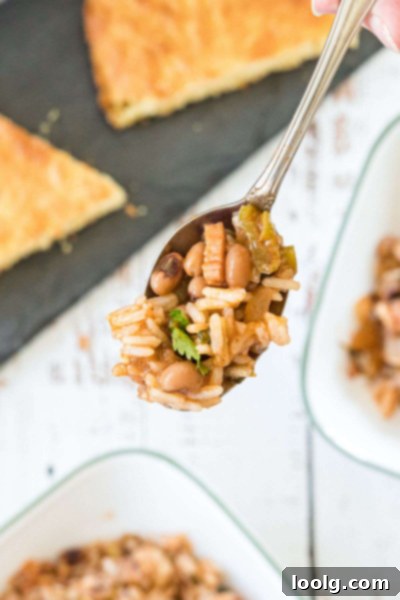
Effortless Cooking: The Magic of the Slow Cooker
One of the most appealing aspects of this Hoppin’ John recipe is its incredible simplicity, thanks to the magic of the slow cooker. This truly is a “set it and forget it” dish, perfect for those bustling New Year’s gatherings or simply when you want a hearty meal with minimal effort. You merely combine nearly all the ingredients into the slow cooker, turn it on, and let the appliance do all the heavy lifting. The low and slow cooking process allows the flavors to meld beautifully, creating a rich and deeply satisfying stew without constant supervision.
While the slow cooker handles the main ingredients, the rice is best cooked separately on the stovetop. This ensures the rice maintains its ideal texture, preventing it from becoming mushy or over-absorbing the liquid within the slow cooker. You can easily prepare your chosen Jasmine or long-grain rice according to package directions in the final hour of Hoppin’ John’s cooking time, ensuring everything is ready to be combined and served warm. This method guarantees perfect results every time, adding to the dish’s overall ease and appeal.
Embracing your slow cooker for this recipe also opens up a world of convenience for other meals. If you’ve got it out, why not try preparing a batch of Healthy Taco Soup or a comforting Kid-friendly Chili? Both are fantastic make-ahead options that freeze wonderfully, providing delicious meals for future busy days. Another family favorite that’s a cinch to make in the slow cooker is this Crockpot Pizza Casserole, guaranteed to be a hit with everyone.
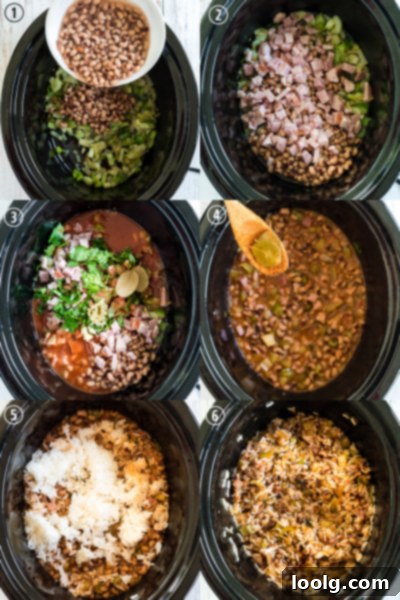
Dietary Considerations: Naturally Gluten-Free and Dairy-Free
For those managing dietary restrictions, Hoppin’ John offers a fantastic naturally gluten-free and dairy-free option. The core ingredients – black-eyed peas, ham (or bacon), vegetables, and spices – are typically free from these common allergens. However, it’s crucial to be diligent when selecting your ingredients, particularly with pre-made seasonings and cured meats, as hidden additives can sometimes compromise the dish’s dietary compliance.
Cajun seasoning, a key flavor component in Hoppin’ John, can sometimes contain wheat or dairy derivatives. For instance, popular brands like Tony Chachere’s may list “may contain wheat or milk” on their labels, which can be devastating news for those needing to strictly avoid these ingredients. To ensure your Hoppin’ John remains truly gluten-free and dairy-free, I highly recommend making your own Cajun seasoning blend. Not only is it a more reliable way to control ingredients, but it’s also often more economical and allows you to customize the spice level. This recipe for Cajun Roasted Cauliflower with Homemade Cajun Seasoning provides an excellent guide for making your own. Once you have a batch, you can also use it to elevate dishes like this delicious Healthy Cajun Chicken Pasta!
Similarly, while ham is typically gluten-free, some pre-packaged hams, especially those with glazes or injected solutions, might contain gluten. Always check the ingredient labels meticulously for any hidden wheat products, starches, or thickeners. Opting for uncured, plain ham or bacon is often the safest bet. By taking these simple precautions, you can confidently enjoy this flavorful and lucky New Year’s meal.

Customizing Your Hoppin’ John: Substitutions and Serving Tips
This Hoppin’ John recipe is wonderfully adaptable, allowing for several substitutions to suit your taste preferences or what you have on hand. Don’t hesitate to make it your own while still embracing its comforting essence.
- **Bacon vs. Ham:** If ham isn’t your preference, cooked bacon makes an excellent substitute. For crispy bacon, cook it separately until your desired crispness and crumble it over the finished Hoppin’ John just before serving. If you prefer softer bacon that melds into the dish, add it along with the other ingredients in the slow cooker.
- **Spice Level with V8 Juice:** The recipe calls for Spicy Hot V8 Juice, which provides a subtle kick without making the dish overly spicy. If you prefer a milder flavor profile, simply opt for V8 Original. V8 juices are known for being 100% vegetable juice blends with no artificial ingredients, ensuring a wholesome addition. If V8 isn’t available or preferred, you can use vegetable broth or even tomato juice for a similar liquid base, adjusting the Cajun seasoning to taste.
- **Bean Alternatives:** While black-eyed peas are traditional for their lucky symbolism, you can certainly use other beans if you wish. Pinto beans are a common alternative and offer a creamy texture. Other options include cannellini beans or kidney beans, though it’s worth noting they won’t carry the same “lucky” connotations as the classic black-eyed peas!
- **Additional Vegetables:** Feel free to boost the nutritional content and flavor by adding other vegetables. Diced carrots, additional bell pepper colors (red, yellow, orange), or even a handful of frozen corn kernels can be delightful additions. Add them at the beginning with the other slow cooker ingredients.
Beyond the traditional collard greens and cornbread, consider garnishing your Hoppin’ John with fresh chopped cilantro, a sprinkle of green onions, or even some cherry tomato halves for a burst of color and freshness. A dash of your favorite hot sauce is also a popular addition for those who enjoy extra heat.
I hope this Slow Cooker Hoppin’ John brings you immense joy and, of course, a year filled with good luck! May 2024 (or whatever year you’re entering) be wonderfully better than the last for all of us. And by the way, if black-eyed peas aren’t entirely your thing, you might enjoy these flavorful rice and beans instead!
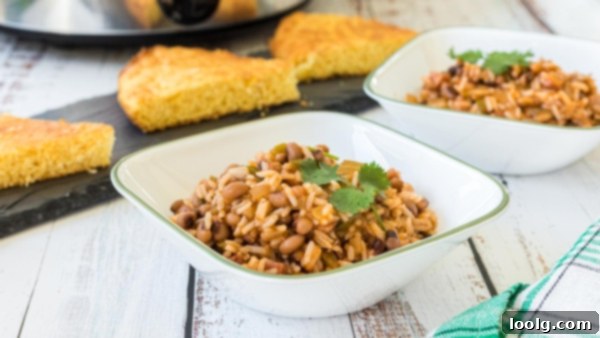
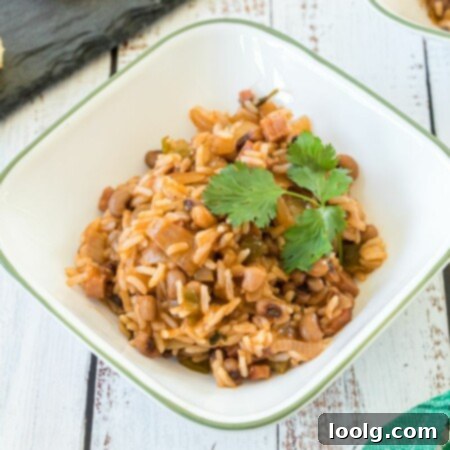
Slow Cooker Hoppin’ John
Ingredients
- one 15-ounce (425-gram) can black-eyed peas
- 3/4 cup onion diced
- 3 stalks celery diced
- 1 small bell pepper any color, diced
- 1 cup smoked ham cut into small bite-sized pieces
- 1/4 – 1/2 cup cilantro chopped (optional)
- salt and pepper to taste
- 1 teaspoon Cajun seasoning (make sure you use a gluten/dairy-free brand, if needed)
- 2 bay leaves
- 1 teaspoon minced garlic
- one 6-ounce can Spicy Hot V8 Juice
- Optional: one 10-ounce (283-gram) can of diced tomatoes
- 1 cup cooked Jasmine or long grain rice of choice
- optional, as garnish: chopped cilantro, cherry tomatoes, crumbled bacon pieces, chopped green onions
Instructions
-
Add all ingredients, except for the cooked rice, to your slow cooker. Cook on low for 2-3 hours until the flavors are well combined and ingredients are tender. If you prefer an extra tomato flavor, feel free to include the optional can of diced tomatoes.
-
Carefully remove and discard the bay leaves from the slow cooker.
-
Stir in the hot cooked rice. If the mixture appears too thick for your liking, or if your rice absorbed a lot of liquid, add a few tablespoons of water at a time until you reach your desired consistency. You might not need this if you opted to add the diced tomatoes earlier. Serve hot.
-
Any delicious leftovers can be stored in an airtight container in the refrigerator for up to 4 days.
